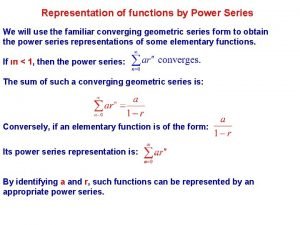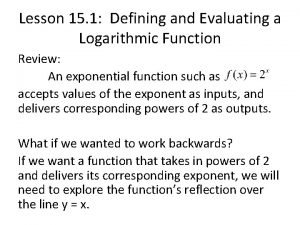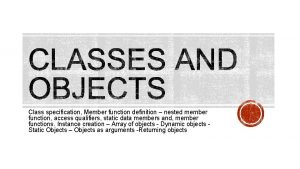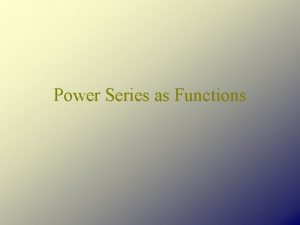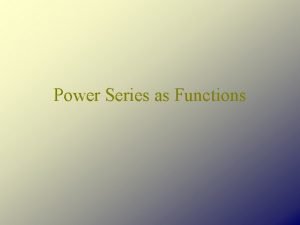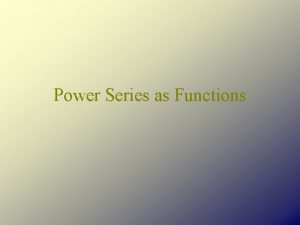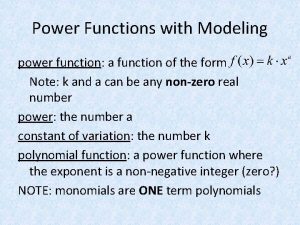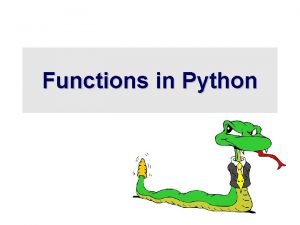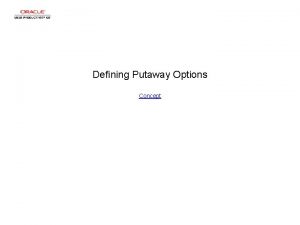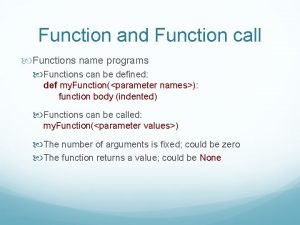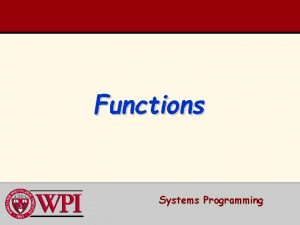Power Series as Functions Defining our Function The






















- Slides: 22

Power Series as Functions

Defining our Function The power series is a function on its interval of convergence. That is, if the series converges at x = a, then define is a number and we can In general, we can say that

Some Questions Arise The main goal of our lesson for today is to consider the sorts of functions that are sums of Power Series: • What are these functions like? • Are power series functions continuous? Are they differentiable? Antidifferentiable? • Can we find formulas for them?

Example • Consider the power series function The ratio test shows that the radius of convergence is ? So the series converges on What is the interval of convergence? (? , ? ) What about the endpoints? I = ? ? ?

Example • To see this idea “in action, ” Consider the power series The ratio test shows that the radius of convergence is 2 So the series converges on What is the interval of convergence? (? , ? ) What about the endpoints? I = ? ? ?

Example • To see this idea “in action, ” Consider the power series The ratio test shows that the radius of convergence is 2 So the series converges on What is the interval of convergence? (1, 5) What about the endpoints? I = ? ? ?

Example • To see this idea “in action, ” Consider the power series The ratio test shows that the radius of convergence is 2 So the series converges on What is the interval of convergence? (1, 5) What about the endpoints? I = [1, 5] The domain of the function

Example—Graphs! • Now use Maple to graph the 30 th, 35 th, 40 th, and 45 th partial sums of the power series Remember that each partial sum is a polynomial. So we can plot it!

Example—Graphs! • This graph shows the 30 th, 35 th, 40 th, and 45 th partial sums of the power series Do you see the graph of f emerging in the picture?

Formulas! Consider an (already familiar) Example Our old friend the geometric series! We know it converges to and diverges elsewhere. That is, whenever |x| < 1

Our first formula! We see the expected convergence on a “balanced” interval about x = 0. Near x = 1, the partial sums “blow up” giving us the asymptote we expect to see there. This plot shows the 10 th, 12 th, 13 th, and 15 th partial sums of this series. Near x = -1 the even and odd partial sums go opposite directions, preventing any convergence to the left of x = -1.

Our first formula! What else can we observe? Clearly this function is both continuous and differentiable on its interval of convergence. It is very tempting to say that the derivative for f (x) = 1 + x 2 + x 3 +. . . should be But is it? For that matter, does this series even converge? And if it does converge, what does it converge to?

It does converge, as we showed in the presentation on power series: The general form of the series is The ratio test limit: So the “derivative” series also converges on (-1, 1). We showed that it diverges at the endpoints.

Differentiating Power Series Does it converge to 6 th partial sum 10 th partial sum The green graph is the partial sum, the red graph is

This graph suggests a general principle: Theorem: (Derivatives and Antiderivatives of Power Series) Let be a power series with radius of convergence R > 0. And let And then • Both D and A converge with radius of convergence R. • On the interval (x 0 – R , x 0+R) S’(x) = D(x). • On the interval (x 0 – R , x 0+R) A’(x) = S(x).

Or to put it more succinctly, if a little less precisely, Theorem: (Derivatives and Antiderivatives of Power Series) If is a power series with radius of convergence R > 0. Then we can differentiate and antidifferentiate S. Moreover, And These all have the same radius of convergence.

Are all Series Functions be Differentiable and Integrable? No. Power Series are very special in this regard! If, instead of adding up powers of x with coefficients, we add up trig functions, we get very different behavior. Consider, for example

The partial sums of the series look like this. 1 st partial sum 2 nd partial sum 8 th partial sum

It gets even worse! The partial sums of the series look like this. 3 rd partial sum 5 th -2 10 th partial sum 1 -1 2

Lest we lose the forest for the trees. . . Let us consider again our original example Even though we can’t find a formula for f, we can still differentiate and antidifferentiate it. What do we get?

Lest we lose the forest for the trees. . . Interval of Conv. What is the radius of convergence?

Lest we lose the forest for the trees. . . Moral: Moral The theorem about differentiating and Recall the function antidifferentiating power series only guarantees “nice behavior” on the interior of the interval. Not at the endpoints! What is the radius of convergence? What is the interval of convergence? AC AC CC AC AC
 Non defining
Non defining Relative clauses defining and non defining
Relative clauses defining and non defining Prepositions in relative clauses
Prepositions in relative clauses Defining and non defining relative clauses in telugu
Defining and non defining relative clauses in telugu Relative clauses virgül kullanımı
Relative clauses virgül kullanımı Non defining relatives clauses
Non defining relatives clauses Representations of functions as power series
Representations of functions as power series The real lesson 21
The real lesson 21 Lesson 15.1 defining and evaluating a logarithmic function
Lesson 15.1 defining and evaluating a logarithmic function Nesting member function
Nesting member function Power function vs polynomial function
Power function vs polynomial function Thinking language and intelligence
Thinking language and intelligence Our census our future
Our census our future Christ be our light
Christ be our light Our life is what our thoughts make it
Our life is what our thoughts make it We bow our hearts we bend our knees
We bow our hearts we bend our knees Our census our future
Our census our future Our life is what our thoughts make it
Our life is what our thoughts make it We quail, money makes us quail.why?
We quail, money makes us quail.why? Awareness of ourselves and our environment is
Awareness of ourselves and our environment is Our awareness of ourselves and our environment is called
Our awareness of ourselves and our environment is called God our father christ our brother
God our father christ our brother Our future is in our hands quotes
Our future is in our hands quotes






